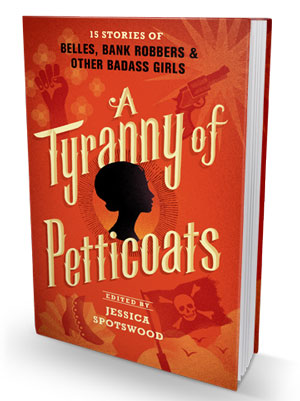 A TYRANNY of PETTICOATS: 15 Stories of Belles, Bank Robbers & Other Badass Girls
A TYRANNY of PETTICOATS: 15 Stories of Belles, Bank Robbers & Other Badass Girls
edited by Jessica Spotswood
Candlewick Press, 347 pages
reviewed by Leticia Urieta
In her introduction to the anthology, A Tyranny of Petticoats: 15 Stories of Belles, Bank Robbers and other Badass Girls, editor and author, Jessica Spotswood, describes her longtime interest in the study of history as something “tactile and ever present,” beyond dates and facts. Spotswood acknowledges the problematic nature of historical writings in the past: “Despite their many contributions, women— especially queer women, women of color, and women with disabilities—have too often been erased from history.” Her acknowledgement captures the spirit of the book; the need to give women authors a chance to fill this absence, and tell the complex stories of young women that mainstream history has forgotten.
Spotswood has collected fifteen authors, including herself, to contribute short stories that reflect the perspectives of girls across different time periods of American history, starting from 1710 and ending in 1968. The collection spans different regions, cultures, classes and linguistic traditions. As a writer, I can imagine the challenges these authors faced to create this wonderful array of stories, to compress the unique historical and regional circumstances into one young woman’s voice, and fulfill her story arc in just twenty or so pages. Other authors have written four hundred-page historical novels that have had difficulty accomplishing this task. Beyond that, how does a writer avoid explanation that bogs down the reader, keeps the story suspenseful, and leaves the reader feeling satisfied, while avoiding emotionally simplistic endings?
This book confronts these challenges and defies expectations. Each story is able to create a complete story arc by dropping the reader into a moment full of danger, possibility, or strife, and lets the protagonist, mostly told in first person point of view, lead the reader through the story. Each author makes a great effort to interweave back-story and context for the historical period into the present action, acclimating us to the environment without giving too much away all at once. This seems standard for any author, but considering how these stories take on the challenge of appealing to different age groups, trying to interest, as well as give, the reader an idea of these young women whose stories have often gone untold, the effort is commendable. While some of the stories sometimes fall in to the trap of explaining too much and slowing the story down, or not giving enough information, leaving the reader floundering a bit, every single author created a voice that made me want to keep reading.

These stories’ successes stem not only from the superb storytelling structures and styles, but also from the protagonists themselves. It’s refreshing to learn something with each story about a time and culture one might not be familiar with, and to understand how, in each period, in each place, these young women fight against the constrains of their gender. Being a fan of Louisa May Alcott’s Little Women as a girl, especially of feisty, strong willed Jo March, I loved experiencing the worlds of these young women, especially women of color that spoke more to my own experiences (as much as I still love Jo).
I appreciated the mixture of realism and magic, and the handling of folklore as a vital way to understand the world for many of the characters. In “The Journey,” a young Inuit woman named Yakone is guided by the red aurora to fulfill her destiny and preserve her village when disaster strikes. In “El Destinos”, three magical Tejana sisters struggle to live typical lives in a newly independent Texas while still carrying out their duties as keepers of other’s fates. “High Stakes” creates a mysterious world in which Klio, an assassin, struggles with her own mythical heritage when pitted against warring magical factions. These magical elements are never treated as fantastical. They are integrated into the way that each young woman sees the world and how the reader experiences the story.
Many of the stories also highlight the struggle that the protagonists have with their society’s expectations of their race and gender. Set in Depression era Washington State, “Hard Times” tells the story of Rose, a homeless youth searching for work. She struggles to keep her charge, Billy, safe while living among men looking to take advantage of her at every turn. In “The Red Raven Ball,” educated, radical Lizzie must rebel against her prominent, wealthy Grandmamma in order to aid the Union in uncovering a Confederate spy in her Washington high society circle. In “The Whole World is Watching”, Jill, a black college student, protests the war in Vietnam at Chicago’s 1968 National Democratic Convention. She battles with her place in the struggle for peace and her own sexual identity in light of her conservative upbringing in rural Tennessee. These women defy expectations, while still being real and relatable.
While all the stories have many elements in common, one theme unites them all—they all end in hope, no matter the outcome. One of my favorite stories (though it was hard to identify just one) is the first story in the collection, “Mother Carey’s Table.” It is told through the wholly unique voice of an escaped slave’s daughter, Jocasta or “Joe,” posing as a young sailor on a pirate ship. Her unexpected description of life at sea, and her realization of what she wants most in life made me devour this story. This line in particular stuck with me long after I’d left it: “There’s no way I could crouch between rows of tobacco now that I’ve felt the foredeck swaying beneath my feet, tasted salt on my lips, and run before the wind in a little sloop under a sky blue enough to make me forget every storm I ever sailed through.” This is an example of what this collection of stories does so beautifully; it brings together stories of young women who, despite being from different time periods, regions, races, classes and cultures, are simply trying to live their most authentic lives, and find hope and conviction under difficult or insurmountable circumstances.
As a reader, diving into an anthology about a subject I am very passionate about, namely historical stories of complex, interesting young women, my challenge was to learn how to read this particular book. My advice is to take your time. Allow each chapter, each character’s voice to envelop you. Inhabit each world for a while, the same way you might if you were reading a four hundred-page novel, because the story is all you get. Reading too quickly will not allow you to get a full sense of each young woman, and it runs the risk of letting the many first person protagonists blur together without truly appreciating their stories. The hardest part of reading this book is leaving behind characters you want to know more of, and wishing you could stay with them just a bit longer. It is a book that, for me, will warrant many return readings.
 Leticia Urieta is a Tejana writer from Austin, TX. She is a graduate of Agnes Scott College and is a fiction candidate in the MFA program at Texas State University. She won Agnes Scott’s Academy of American Poet’s prize in 2009 and her work has appeared in Cleaver, the 2016 Texas Poetry Calendar, and Blackheart. Leticia lives in Austin, Texas with her husband and two dogs. She is using her love of Texas history and passion for research to write a historical novel about the role of Mexican soldaderas in Texas’ war with Mexico.
Leticia Urieta is a Tejana writer from Austin, TX. She is a graduate of Agnes Scott College and is a fiction candidate in the MFA program at Texas State University. She won Agnes Scott’s Academy of American Poet’s prize in 2009 and her work has appeared in Cleaver, the 2016 Texas Poetry Calendar, and Blackheart. Leticia lives in Austin, Texas with her husband and two dogs. She is using her love of Texas history and passion for research to write a historical novel about the role of Mexican soldaderas in Texas’ war with Mexico.
Read more from Cleaver Magazine’s Book Reviews.



